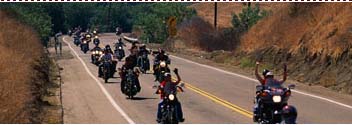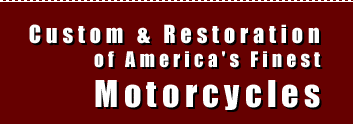|

  
Hot XL - Spring 1999
The Executioner
By Alex Scott
King of the flat track for a quarter of a century, the Harley-Davidson
XR 750 screams "performance." It's the only motorcycle
to reign almost unchallenged for so long. The XR is also cousin
to the milder-mannered XL Sportster.
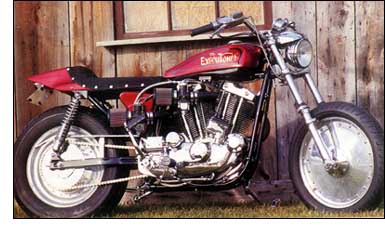 Wymond
Walkem's hybrid, best of both worlds - the handling and performance
of the XR with the convenience and practicality of the XL. But why
is it called "The Executioner?" Maybe because it's stock
heads were cut off long ago, or maybe because it'll blow away any
competition quicker than an axe swung into an oak stump. "I
used to have nitrous hooked up," Wymond says, "but once
the motor blew so bad the connecting rods smashed out of the cases
and bent the frame. Didn't need that bottle anyway. The bike has
enough power without it to off just about anything." Wymond
Walkem's hybrid, best of both worlds - the handling and performance
of the XR with the convenience and practicality of the XL. But why
is it called "The Executioner?" Maybe because it's stock
heads were cut off long ago, or maybe because it'll blow away any
competition quicker than an axe swung into an oak stump. "I
used to have nitrous hooked up," Wymond says, "but once
the motor blew so bad the connecting rods smashed out of the cases
and bent the frame. Didn't need that bottle anyway. The bike has
enough power without it to off just about anything."
What's the reason for the bike's supremacy? Those squarish cylinders
and heads, which aren't XR items at all (even though each head has
its own Mikuni flat track style VM model carburator). The top end
was made by Alan Sputhe, the genius of Harley performance at Sputhe
Engineering, way back in 1980, before the sun set on the AMF empire.
 The
lightweight alloy components weigh a fraction of the Sportster's
original iron head and barrel and, legend has it, are lighter even
than the XR 750's featherweight racing components. More importantly,
the engine now displaces 77 inches and dissipates heat quickly,
which allows the motor to develop huge amounts of horsepower without
burning up (unless you turn up the nitrous, that is). The
lightweight alloy components weigh a fraction of the Sportster's
original iron head and barrel and, legend has it, are lighter even
than the XR 750's featherweight racing components. More importantly,
the engine now displaces 77 inches and dissipates heat quickly,
which allows the motor to develop huge amounts of horsepower without
burning up (unless you turn up the nitrous, that is).
Many years ago, Canadian native Wymond visited L.A. and found himself
working just a block away from Sputhe. Not so long afterward, he
was riding a 650cc single-cylinder Sportster up to 129mph on the Bonneville
Salt Flats. That's about 30 mph faster than most Sportster owners
have ever ridden with two cylinders! How do you get a Sportster
single? Easy - just lop off one of its heads, and cylinders, and
pistons, and connecting rods. Then add a Sputhe top end. Now you've
got something that could compete with the Triumph, BSA and Norton
twins in the 650cc class. And beat them.
Around the same time, Wymond happened to have brought his Sportster-engined
XR down with him from Canada. So that XL motor, already highly modified,
got the full top end treatment. Then, fearing his motorcycle would
start a new California trend, Wymond hotfooted it back to Canada
where the bike has stayed ever since.
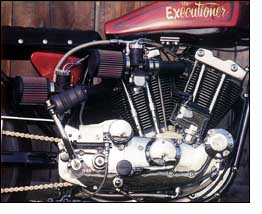 And
what's up with the chassis? How that powerful motor got itself installed
in an XR chassis is quite another story. Up north in Ontario, at
the end of the 1970s, flat track racers were replacing their mounts'
stock frames with newer aftermarket items. Those engine-less race
frames were quickly snapped up. Many were converted into quick-handling
street bikes. After Wymond got his XR frame, he raked the neck out
about five degrees over stock to make the steering suitable for
the street and strip. "Five degrees extra rake makes it so
the front wheel isn't coming off the ground all the time,"
Wymond states. He then bought a brand new iron-barrel 1000cc XL
engine in a crate from Harley-Davidson (yes, we're talking quite
a few years ago). The Sportster motor has advantages over the XR
version for street use. As Wymond says, "The problem with the
XRs is that they never have provision for a generator. That's why
I went with Sportster cases. Also, the XR cases have only a limited
amount of room for overboring. You're pretty much limited to 750cc.
If a guy running a 45-inch (750cc) XR tells me he can blow me off,
I tell him now way - not with Sputhe heads and barrels and 77 cubic
inches." And
what's up with the chassis? How that powerful motor got itself installed
in an XR chassis is quite another story. Up north in Ontario, at
the end of the 1970s, flat track racers were replacing their mounts'
stock frames with newer aftermarket items. Those engine-less race
frames were quickly snapped up. Many were converted into quick-handling
street bikes. After Wymond got his XR frame, he raked the neck out
about five degrees over stock to make the steering suitable for
the street and strip. "Five degrees extra rake makes it so
the front wheel isn't coming off the ground all the time,"
Wymond states. He then bought a brand new iron-barrel 1000cc XL
engine in a crate from Harley-Davidson (yes, we're talking quite
a few years ago). The Sportster motor has advantages over the XR
version for street use. As Wymond says, "The problem with the
XRs is that they never have provision for a generator. That's why
I went with Sportster cases. Also, the XR cases have only a limited
amount of room for overboring. You're pretty much limited to 750cc.
If a guy running a 45-inch (750cc) XR tells me he can blow me off,
I tell him now way - not with Sputhe heads and barrels and 77 cubic
inches."
The clutch needed to handle all that power wasn't found in the
'77 engine's crate. Instead, the resourceful Wymond had to go back
to Harley's pre-electric start 1969 XL. Only now the problem was
how to disengage it, seeing as the worn gear actuating mechanism
had changed sides in the interim. He solved the problem with a Routt
hollow mainshaft (sadly, no longer available), 1969 Sportster transmission
push rods, and a little machining work on the primary side (to remove
the worm gear that activates the push rod) and the sprocket cover
side (to install it).
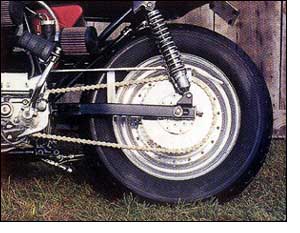 Yet
more innovative engineering means that the electric tach runs off
a dummy set of points installed inside the cam cover while a magneto
handles the real ignition duties. Yet
more innovative engineering means that the electric tach runs off
a dummy set of points installed inside the cam cover while a magneto
handles the real ignition duties.
Strangely, the owner reckons that there were more XR street bikes
around in Canada in the 70s than there were south of the border,
and not too many bikes anywhere with the Sputhe equipment. Sputhe
sold around 50 sets of the XR replica heads and barrels around that
time, but told Wymond, "You're one of the few guys who has
actually finished the bike enough to get it on the road." The
Sputhe heads and cylinders are light, powerful and well thought
out. No gaskets are used - instead the joints are lapped to seal.
Also, through studs secure the heads firmly in place. "Those
parts were years ahead of their time," says Wymond.
Perhaps it's not surprising then that this motorcycle had hardly
been used since the early 80s, especially because Wymond has a fleet
of other bikes to ride. He resuscitated the XR last year, after
the bike had been neglected for a decade. After sitting for that
long, the tires had rotted and all the polished parts were white
with aluminum oxide. Wymond dismantled, cleaned, polished and chromed
the bike, fitted the magneto, and added better tires and roller
rockets. "Now that modern rubber is installed, the bike handles
all the corners you can throw at it," says Wymond. "It's
one of those bikes that has to be a solo ride - because little else
can keep up on the straights or the corners."
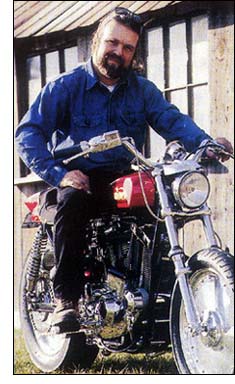 The
sharp-eyed reader will notice an oil filter installed in place of
the Sportster starter motor. The started was removed for a number
of reasons, the biggest being that the 1969 clutch hub rendered
it inoperable. It was also deemed expendable because of the XR's
lack of battery power and its additional weight. The
sharp-eyed reader will notice an oil filter installed in place of
the Sportster starter motor. The started was removed for a number
of reasons, the biggest being that the 1969 clutch hub rendered
it inoperable. It was also deemed expendable because of the XR's
lack of battery power and its additional weight.
Many pieces - like the engine's outer case and lower fork legs
- used to be polishes, but Wymond found that keeping up the polish
was hell in Canada's harsh weather and Daytona's salt spray. He
opted for chrome instead. Thinking back to when he first built the
bike, some 20 years ago, Wymond is astounded that although the allure
of the XR remains, everything else has changed. "Now all the
stuff is available to make a great machine. When I first had this
bike it has Hurst/Airheart brakes and we could only get one tire
to fit the rear wheel: a Michelin car tire. In fact, the lighting
system was flashlight batteries. Now it's so dependable, with no
leaks or problems and great brakes. It's one of the most reliable
motorcycles around. Getting rid of the XL's stock ignition advance
system was a great move because the weight would just throw themselves
into orbit when the throttle was opened. Since we installed the
magneto, it's a one-kick starter."
So watch out if you venture north of the border: The Executioner
is still looking for more victims.
|
